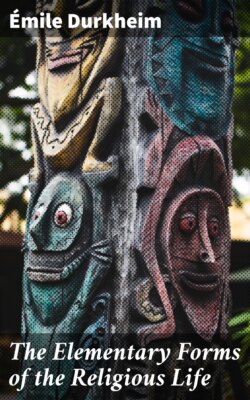Читать книгу The Elementary Forms of the Religious Life - Durkheim Émile - Страница 20
На сайте Литреса книга снята с продажи.
CHAPTER III LEADING CONCEPTIONS OF THE ELEMENTARY RELIGION—continued II.—Naturism
ОглавлениеTable of Contents
The spirit of the naturistic school is quite different. In the first place, it is recruited in a different environment. The animists are, for the most part, ethnologists or anthropologists. The religions which they have studied are the crudest which humanity has ever known. Hence comes the extraordinary importance which they attribute to the souls of the dead, to spirits and to demons, and, in fact, to all spiritual beings of the second order: it is because these religions know hardly any of a higher order.[135] On the contrary, the theories which we are now going to describe are the work of scholars who have concerned themselves especially with the great civilizations of Europe and Asia.
Ever since the work of the Grimm brothers, who pointed out the interest that there is in comparing the different mythologies of the Indo-European peoples, scholars have been struck by the remarkable similarities which these present. Mythical personages were identified who, though having different names, symbolized the same ideas and fulfilled the same functions; even the names were frequently related, and it has been thought possible to establish the fact that they are not unconnected with one another. Such resemblances seemed to be explicable only by a common origin. Thus they were led to suppose that these conceptions, so varied in appearance, really came from one common source, of which they were only diversified forms, and which it was not impossible to discover. By the comparative method, they believed one should be able to go back, beyond these great religions, to a much more ancient system of ideas, and to the really primitive religion, from which the others were derived.
The discovery of the Vedas aided greatly in stimulating these ambitions. In the Vedas, scholars had a written text, whose antiquity was undoubtedly exaggerated at the moment of its discovery, but which is surely one of the most ancient which we have at our disposition in an Indo-European language. Here they were enabled to study, by the ordinary methods of philology, a literature as old as or older than Homer, and a religion which was believed more primitive than that of the ancient Germans. A document of such value was evidently destined to throw a new light upon the religious beginnings of humanity, and the science of religions could not fail to be revolutionized by it.
The conception which was thus born was so fully demanded by the state of the science and by the general march of ideas, that it appeared almost simultaneously in two different lands. In 1856, Max Müller exposed its principles in his Oxford Essays.[136] Three years later appeared the work of Adalbert Kuhn on The Origin of Fire and the Drink of the Gods,[137] which was clearly inspired by the same spirit. When once set forth, the idea spread very rapidly in scientific circles. To the name of Kuhn is closely associated that of his brother-in-law Schwartz, whose work on The Origin of Mythology,[138] followed closely upon the preceding one. Steinthal and the whole German school of Völkerpsychologie attached themselves to the same movement. The theory was introduced into France in 1863 by M. Michel Bréal.[139] It met so little resistance that, according to an expression of Gruppe,[140] "a time came when, aside from certain classical philologists, to whom Vedic studies were unknown, all the mythologists had adopted the principles of Max Müller or Kuhn as their point of departure."[141] It is therefore important to see what they really are, and what they are worth.
Since no one has presented them in a more systematic form than Max Müller, it is upon his work that we shall base the description which follows.[142]
